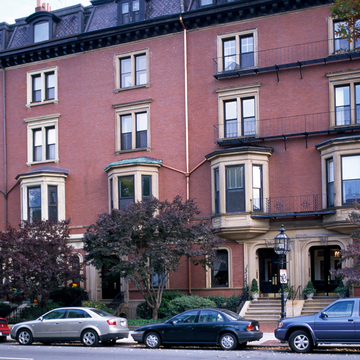Samuel Hooper and his son shared what was an unusual example of a Back Bay dwelling with an open side yard at the corner of Berkeley Street. Combined with the alley in the rear, this gives the Samuel Hooper House three elevations open to natural light. The house itself is one of the most elegant examples of the Second Empire style in Boston, with octagonal bays projecting up into the mansard roof. Arthur Gilman, who was presumably the principal architect, used pressed brick contrasted with the tan sandstone of a high rusticated basement, dentillated cornice, and lavish door and window surrounds. The Hooper House suggests how Commonwealth Avenue might have developed had the high cost of building lots on the street not encouraged the construction of continuous row houses to maximize investments.
The same architects were responsible for just such a project on the opposite side of Commonwealth Avenue at numbers 20–36. This block of nine houses illustrates some of the same elegant detailing evident on a more lavish scale in the Samuel Hooper House. The block forms a continuous roof line, a feature that makes it easy to identify row houses built in Boston prior to 1873, when the revisions of the fire code required a masonry party wall at the attic level of each house.

